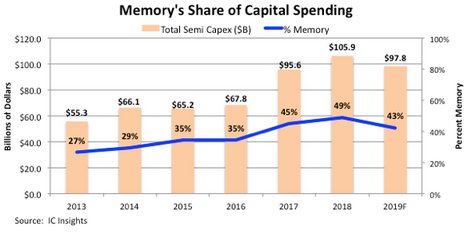Memory Forecast to Account for 43% of Total 2019 Semi Spending
Foundry to account for most semi capex spending in 2019 as the big wave of spending for memory fab expansions and upgrades comes to a close.
September 10, 2019 -- Capex spending for memory ICs was the driving factor behind very strong increases in industry-wide capex spending over the past two years. Most of those upgrades and expansion plans are now completed or have entered their final building phases. As a result, memory capex is forecast to account for 43% of total semi industry capital spending this year, down from 49% in 2018 (Figure 1). Total semiconductor capital expenditures are forecast to slip 8% in 2019 to $97.8 billion following the record high spending level of $105.9 billion set in 2018.

Figure 1
The share of capital spending for memory devices has increased substantially in seven years, growing from 27% ($14.7 billion) in 2013 to a record high level of 49% ($52.0 billion) in 2018 to a forecast of 43% ($41.6 billion) of total industry capex in 2019, which equates to a 2013-2019 CAGR of 18.9%.
The IC product segment receiving the most spending in 2017 and 2018 was the Flash/Non-Volatile memory category. However, with Samsung, SK Hynix, and Micron adding capacity for both DRAM and NAND flash and Intel, Toshiba Memory/Western Digital/SanDisk, and XMC/Yangtze River Storage Technology all significantly ramping up 3D NAND flash capacity over the past 18 months, the DRAM and NAND flash memory markets have entered a period of overcapacity and pricing weakness. This is evident by the steep decline in the price per bit of both DRAM and NAND flash and the steep cutback in capex spending forecast for 2019.
In 2019, capital spending in the DRAM and Flash memory segments is expected to drop by 19% and 21%, respectively (Figure 2). Total memory capital spending is expected to be $41.6 billion in 2019, a decline of $10.4 billion from last year. The big cutbacks in spending in the DRAM and flash market segments this year are an attempt by the major memory suppliers to prevent further price erosion in the second half of 2019 and into 2020. How far memory prices continue to fall will be determined in large part by how much memory suppliers trim their capital spending for these devices this year and next and if lower price per bit triggers additional bit volume demand.

Figure 2
Report Details: The 2019 McClean Report
Details on capital spending and other trends within the IC industry are provided in The McClean Report—A Complete Analysis and Forecast of the Integrated Circuit Industry. A subscription to The McClean Report includes free monthly updates from March through November (including the Mid-Year Update), and free access to subscriber-only webinars throughout the year. An individual-user license to the 2019 edition of The McClean Report is priced at $4,990 and includes an Internet access password. A multi-user worldwide corporate license is available for $7,990.
Related Semiconductor IP
- HBM4 PHY IP
- Ultra-Low-Power LPDDR3/LPDDR2/DDR3L Combo Subsystem
- HBM4 Controller IP
- IPSEC AES-256-GCM (Standalone IPsec)
- Parameterizable compact BCH codec
Related News
- Global 300mm Fab Equipment Spending Forecast to Reach Record $119 Billion in 2026, SEMI Reports
- 300mm Fab Equipment Spending Forecast to Reach Record $137 Billion in 2027, SEMI Reports
- Intel and Samsung Forecast to Represent 42% of Semiconductor Capital Spending in 2013
- Gartner Says Worldwide Semiconductor Capital Spending Is Forecast to Grow 2.9 Percent in 2017
Latest News
- Rivian Unveils Custom Silicon, Next-Gen Autonomy Platform, and Deep AI Integration
- NanoXplore raises €20 million from MBDA and Bpifrance to accelerate its diversification into defense and its growth in support of European strategic sovereignty
- Omni Design Technologies Appoints Hinesh Shah as Vice President of Strategic Sales
- DHRUV64: India’s First 1.0 GHz, 64-bit dual-core Microprocessor
- QuickLogic Announces Expanded Scope of Strategic Radiation Hardened FPGA Contract